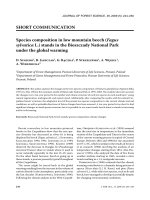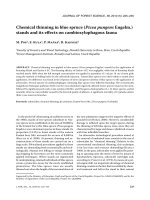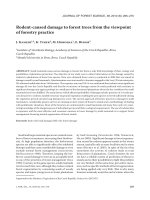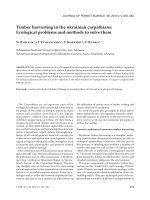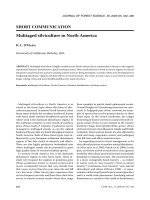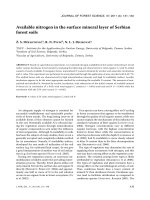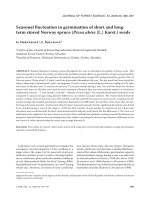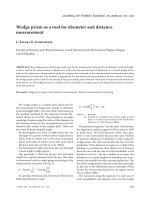Báo cáo lâm nghiệp:" Ring shake in chestnut: Anatomical description, extent and frequency of failures" pdf
Bạn đang xem bản rút gọn của tài liệu. Xem và tải ngay bản đầy đủ của tài liệu tại đây (1.29 MB, 6 trang )
403
Ann. For. Sci. 60 (2003) 403–408
© INRA, EDP Sciences, 2003
DOI: 10.1051/forest:2003032
Original article
Ring shake in chestnut:
Anatomical description, extent and frequency of failures
Patrick FONTI
a
*, Nicola MACCHIONI
b
a
WSL Swiss Federal Research Institute, Sottostazione Sud delle Alpi, via Belsoggiorno 22, Casella postale 57, 6504 Bellinzona, Switzerland
b
Istituto per la Valorizzazione del Legno e delle Specie Arboree, Consiglio nazionale delle ricerche, via A. Barazzuoli 23, 50136 Firenze, Italy
(Received 26 March 2002; accepted 21 November 2002)
Abstract – Ring shake is a wood defect that occurs very frequently in sweet chestnut (Castanea sativa Mill.). By examining this particular kind
of wood failure it is apparent that, at an anatomical level, separations occurring in the wood tissue show different features. In order to collect
further information to help in understanding the causes that lead to the development of ring shake, a microscopic description and a quantification
of these different ring shake typologies has been performed on 45 chestnut wood discs. Results showed that among the various shake types
encountered, the crack-form, i.e. the failure that develops across the earlywood cell walls, is largely the most frequent and is principally found
in fresh felled wood. Detailed observations reinforce the belief that the set off mechanism leading to crack-failure is related to the combined
interaction of the structural weakness of chestnut wood with growth stresses developed in the stem.
Castanea sativa / ring shake / fracture anatomy
Résumé – La roulure du châtaignier : description anatomique, ampleur et fréquences des séparations. La roulure est un défaut du bois
qui se produit très fréquemment dans le châtaignier (Castanea sativa Mill.). En examinant ce genre particulier de rupture il est visible au niveau
anatomique que les séparations qui se produisent dans le bois montrent des faciès de rupture différents. Afin de disposer d'informations
nécessaires à la compréhension des causes qui mènent au développement de la roulure, une description microscopique et une quantification des
différentes typologies de roulure ont été effectuées sur 45 disques de châtaignier. Les résultats ont montré que parmi les divers types de roulure
observés, la forme de rupture “crack”, c’est-à-dire la séparation qui se développe à travers les parois cellulaires des vaisseaux du bois initial,
est la plus fréquente et se présente principalement dans le bois fraîchement abattu. Les observations microscopiques détaillées renforcent la
conviction que le mécanisme conduisant à cette forme de rupture est lié à la faiblesse structurale du bois de châtaignier combinée avec les
contraintes de croissance développées dans la tige.
Castanea sativa / roulure / anatomie de fracture
1. INTRODUCTION
Looking at the stem cross-section of different wood species
we can observe the presence of circular failures running parallel
to the growth ring which strongly downgrade otherwise valuable
timber. This particular kind of tangential shake is commonly
called “ring shake” and is defined as “a lengthwise separation
of wood which occurs between and parallel to the growth lay-
ers”. The development of such fractures depends on the bal-
ance between stresses and strength: when the first one exceeds
the second then the shake opens. The literature analysis reveals
many different opinions as to the causes of shake, but all either
refer to an increase of stresses due to the effect of wind [10,
26], frost [8, 10], sudden changes in diameter growth rates
[12], relieving of growth stresses [1, 13]; or to a weakened
wood strength caused by cambial damage [11, 16, 18, 21, 22,
25], environmental stress [25] or by a lack of substances in the
soil and the tree [14]. Several studies based on the description
of the anatomical features of shake surfaces permitted further
discussion about the possible causes of ring shake and about
when the separation have likely occurred [16, 17, 25].
Castanea sativa is an hardwood specie that is very often
affected by ring shake [4]. In this specie different types of ring
shake separations have been observed. Chanson et al. [3], consid-
ering the origins of the split, distinguished between “traumatic”
and “healthy” ring shake. The first type is always related to vis-
ible anomalies in the wood tissue, whereas for the second
one the splitting appears to be unrelated to any recognizable
anatomical perturbation. Moreover, among these two types,
three additional anatomical fracture surfaces have also been
* Corresponding author:
404 P. Fonti, N. Macchioni
observed: the “overlay”, that corresponds to a new layer super-
posed on traumatic cells; the “detachment”, that appears as a
separation along the compound middle lamella between cells
but leaving intact the cell walls; and the “crack”, where the
failure develops across the earlywood vessel cell walls [7].
While it is clear that the overlay originates from cambium
damage, the reasons for the development of the other two fea-
tures are rather unclear, even if all the authors dealing with this
specie agree on the mechanical failure hypothesis. It is how-
ever possible that the cracks and the detachment features have
different origins or developmental processes that lead to dis-
similar anatomical failure characteristics. Thus these aspects
have to be taken into account when inquiring into the possible
causes of ring shake. To this date, however, few descriptive
studies on the anatomical characteristics of the ring shake
zones in chestnut have been carried out [3, 20].
The objective of this research is therefore to perform a
detailed description of the different anatomical ring shake
fractures. In particular we aim to furnish a report on wood sur-
face separations from the anatomical point of view, as well as
a quantification of their extent and frequency. We hope there-
fore, through this new knowledge, to contribute to the discus-
sion of the possible causes leading to ring shake in chestnut
wood.
2. MATERIALS AND METHODS
The wood material used for this study originates from 2 mature
coppice stands situated in Bedano and Bedigliora, in the Southern
part of the Swiss Alps. Both stands have been growth unmanaged
since the last coppicing which occurred in the 1940s. From each stand
at least 20 dominant shoots were selected from the overstory trees,
24 from the stand in Bedano and 21 from that of Bedigliora. Immedi-
ately after the felling, 5 cm thick wood discs were gathered from the
stem base (50 cm above ground level) of each selected shoot. The
collected discs were then polished with a 150 grit sand paper in order
to obtain a clean cross-section allowing an easy identification and
characterization of the anatomical details of the different ring shake
typologies. The observations were performed on each wood disc
twice: once on the fresh collected green wood discs, i.e. within 3 days
after the tree-felling (discs were stored in a controlled environment at
20 °C and 90% relative humidity), and then repeated on the same
wood discs after being dried in fresh air under shelter for about
1year.
The characterization and quantification of ring shake was per-
formed on the disc cross-sections (Fig. 1). All visible tangential fail-
ures longer than 1 cm were taken into account. Each single ring shake
was then characterized by its position on the disc (distance from the
pith, orientation and solar year of the annual ring affected by the
split), length and type of wood failure (overlay, detachment or crack).
Using a Scanning Electron Microscope (SEM Philips XL 20), a
detailed micro-anatomical description of the surfaces of the different
failure typologies was made on the tangential and/or transversal plane
of few samples (two from each ring shake typology) from the col-
lected wood material. After boiling in water microscopic samples
were cut on the transversal and radial planes, without altering the tan-
gential surface failure caused by ring shake.
3. OBSERVATIONS
3.1. Anatomical features of shake zone
3.1.1. Overlay
The overlay-form is not exactly a fracture because a con-
nection between the two separated layers never existed. In
fact, as a cicatrisation caused by cambial damage, the tree
from the near non-traumatic tissue just superposed, without
any physical connection, a new annual increment layer onto
the traumatic one. Moreover, as a consequence of micro-
organisms that penetrated the wound, the nearby zone often
displays discoloration and decay. The overlay-form is there-
fore easy to recognise thanks to the characteristic overgrown
callous tissue and the discoloration in the nearby area (Fig. 2).
The injury causing the cicatrisation is a sudden event that acts
on the last formed tissue: its aspect is then random and its ana-
tomical description cannot be generalised.
3.1.2. Detachment
The fractures of the detachment typology are mainly located
along the boundary between two annual rings, even if from
time to time a small excursion into the earlywood area is noted,
giving therefore the impression of a “crack” failure (Fig. 3).
The failed surface is mainly smooth because the mechanism of
tissue failure is a cell-to-cell debonding from the compound
middle lamella rather than a cell wall failure. As Figure 3
shows the failed surface does not exhibit any sign of cell crack-
ing, even for the parenchyma ray cells, whose walls at the end
of the annual growth ring are still intact. Here the ray cells are
broken flush with the surface. A special case of detachment
that also rarely occurs is discoloured detachment, which is a
disconnection that occurs due to a weak bond between cells
resulting from trauma and decay. Therefore, some discolora-
tion in proximity of the detachment is clearly visible.
3.1.3. Crack
From the anatomical point of view the crack-typology is
essentially a cell wall failure that mainly develops in the tan-
gential plane crossing the first or second row of earlywood
Figure 1. Schematic location of shakes on disc. The year of the
annual ring is represented by thin lines, one each 10 rings starting
from year 1955.
Ring shake typologies in chestnut 405
vessels (Fig. 4). The rough failed surface (tangential section)
is characterised by radial parenchyma cells (uniseriate rays)
that still denote the pulling effect that occurred during the
opening of the failure, as well as by broken vessels and dis-
rupted fibres.
3.2. Extent and frequency of shakes
From the 45 selected wood discs, only few were ring shake
free. In fact only 8 (18%) green discs and 4 (9%) dried discs
showed no ring shake. Few other discs, 6 (13%) green and 7
(16%) dried, were only slightly affected by ring shake, i.e. the
total ring shake failure length was less than 20 cm. This means
that 69% of the green and 75% of the dried discs displayed
more than 20 cm of failure length. Among these, there were
two extremely shaken discs that exhibited more than 3 m of
ring shake failure length.
As shown in Table I, the crack-form is largely the most fre-
quent failure typology, representing 88% (90% for the stand of
Bedigliora and 86% for Brione) of all the ring shakes observed
in green wood, while in the dried wood this proportion slightly
diminishes to 84% (81% for Bedigliora and 86% for Brione).
The other two failure typologies are instead less recurrent with
11% (green) and 15% (dried) being of the detachment typol-
ogy and about 2% of the overlay-form, which of course did not
increase with the drying.
The green wood ring shakes represent 70% (3260 cm) of
the entire observed ring shakes, while a further 30% (1368 cm)
developed during the drying process (Tab. I). These last
formed fractures have been mainly surveyed on discs that
were already affected by the defect (Fig. 5). The more the
green wood is affected by ring shakes, the more ring shakes,
in particular of the crack typology, tend to develop during the
drying-process, confirming previous observations performed
by Fonti et al. [6].
3.3. Shake distribution
The analysis of the ring shake distribution according to the
year of the annual ring, differentiated between the two stands,
shows that both the detachment and crack-form are not strictly
related to specific annual increments (Fig. 6). Looking how-
ever at each single wood disc we often observed that failures,
in particular the crack-form, follow one ring for some distance
but then rather abruptly cross radially into a neighboring ring
and then further proceed into the earlywood tissue. This
“jumping” from ring to ring could also occur several times in
the same ring shake failure, giving the failure a zigzag shape.
4. DISCUSSION AND CONCLUSION
4.1. Origin
Several authors mainly associated ring shake formation
with injuries [11, 16, 18, 21, 22, 25]. In this descriptive study
on chestnut wood, ring shakes originating from an evident
traumatic event (overlay) represented only 1% of all the fail-
ure lengths observed.
The detachment-shake, i.e. failure arising in the compound
middle lamella layer, is somewhat more frequent (15%). In the
literature this kind of fracture was often reported as being
located in the latewood area and associated with green wood
ring shake [11, 15, 17]. In our study however the separation
always appears at the ring boundary and can be found both in
green wood and as a result of the drying process. In her study,
Saya [20], possibly describing such a fracture, has observed a
compound middle lamella lignin deficiency. This could be
indicative of external events that influenced the bonding-quality
between annual growth layers. Genetics, lack of substances in
the soil [14] or damage to the tree may be reasons for the poor
bonding-quality. In fact, if the shake is observed at a point far
from the wound, the association of the wound with the shake
will not be directly recognised [22]. The rarely observed dis-
coloured detachment-form supports this suggestion. And finally,
as there is no apparent relationship between specific annual
Table I. Summary of the ring shake failure length observed in green and dried wood discs differentiating between the different failure
typologies.
Ring shake failure length Green wood discs Increment due to drying Dried wood discs
C D O S C D O S C D O S
Bedigliora cm 1205 116 21 1342 451 252 – 703 1655 369 21 2045
% 90 9 1 100 64 36 0 100 81 18 1 100
Brione cm 1650 229 39 1918 583 81 – 655 2233 310 39 2583
% 86 12 2 100 88 12 0 100 84 15 1 100
Total cm 2855 345 60 3260 1034 333 – 1368 3889 679 60 4628
% 88 11 2 100 76 24 0 100 84 15 1 100
C = Crack, D = Detachment, O = Overlay, S = Sum of all typologies.
Figure 2. Overlay-form: the ring shake is due to the physical
separation of the injured tissue and the cicatrisation tissue.
406 P. Fonti, N. Macchioni
increments and the occurrence of this kind of shake, the open-
ing may rather be associated with single tree events. However,
cambial damage as a cause of ring shake must be taken as a
special case, and does not account for the majority of shake.
The most frequent feature observed is indeed the crack-form,
i.e. ruptures in which the cell walls are usually broken, which
represented 84% of the total ring shake failures surveyed. In
chestnut this separation principally develops in the earlywood area
Figure 4. Crack-form: the rough surface (on the left) is due to the fracture pattern running between the earlywood vessels; the aspect of the ray
tissue (on the right) is similar to that of “pulled” cells.
Figure 5. Ring shake increment observed on each
single disc during the drying process.
Figure 3. Detachment-form: the failed surface is generally smooth even if a small excursion into the earlywood area sometimes occurs (on the
left image); the right image shows the aspect of the radial parenchyma cells which are occluded between annual ring membranes.
Ring shake typologies in chestnut 407
proceeding across the large earlywood vessels. The fracturing
that occurs appears to involve a minimal quantity of wood.
With no noticeable abnormal wood tissue in the shake sur-
face, this shake-form has therefore a merely mechanical origin,
which is regulated by the interaction between the strengths and
stresses in the wood.
The ring porous wood structure and the small uniseriate
rays in chestnut confer a privileged (weak) plane for the opening
and propagation of this kind of tangential failure. The early-
wood zone is an area of structural weakness and therefore
especially vulnerable to stresses which could cause separation.
The timing in which fractures occur, which is generally before
timber processing, and the often observed ring-to-ring jump-
ing pattern of shakes lets us presume that the set off mecha-
nism leading to this failure has to be related to stresses acting
on the standing tree or on the fresh felled stem.
These observations highlight therefore former hypotheses
that the mechanism leading to crack separation is related to the
interaction between wood fragility and the release of growth
stresses [1, 2, 9, 13, 24]. The increase of new ring shake during
the drying process, limited to already severely shaken green
wood discs, could therefore indicate that each single disc has its
own susceptibility to ring shake, which continues on into the drying
process. This may lead back to an intrinsic fragility or to an
amount of unrelieved stress specific to the considered individual.
4.2. Hypothesis on the mode of loading responsible
for the different ring shake forms
Based on the performed morphological description of the
surface failures a preliminary supposition about the responsi-
ble mode of fracture can be formulated. As opposed to trau-
matic ring shake, healthy ring shake has a mechanical origin.
However from simple fracture morphological observation it is
difficult to advance a hypothesis on the typologies of stresses
(mode I, II or III) imposed on the transversal/radial wood
plane, even if some indications suggest allocating the crack
typology to mode I and the detachment typology to mode II.
No studies of ring shake in chestnut wood have compared the
aspect of the ring shake failures to those of the typologies of
stresses imposed on the transversal-radial plane of wood. But
modelling the mode I and II crack propagation on spruce
(Picea abies Karst.) wood, Tan et al. [23] analysed by means
of SEM the longitudinal tangential surface fractures. Taking
into account the differences between spruce and chestnut
wood, we can observe that the mode I produces fracture sur-
faces located within the earlywood, breaking the cell walls,
resulting in an aspect similar to what we have called “crack”.
In spruce wood the mode II produces a large number of
warped broken tracheids, while the behaviour of chestnut
fibres is different and the mode I fracture causes the detach-
ment of adjacent fibres along the compound middle lamella.
An unpublished thesis from Pozzi [19] attempted an ana-
tomical comparison between the crack- and detach-failure ring
shake typologies and those of samples artificially broken in
the tangential plane through radial bending and radial shear.
This study revealed that samples broken through radial bend-
ing performed on green wood (mode I) are similar to the
“crack-form” with the fissure breaking the thin and weak cell
walls of the first and second rows of earlywood vessels
(Fig. 7), while the shear fractures in dried wood samples are
similar to the “detachment-form” (Fig. 8). It is therefore rea-
sonable to suppose that each typology of ring shake has its
Figure 6. Ring shake distribution.
Figure 7. Facet of chestnut wood broken by radial bending test: the
fracture line runs along the earlywood vessels as in the “crack” form
(image Pozzi [19]).
408 P. Fonti, N. Macchioni
own mechanism. Further investigation may help in establish-
ing which fracture mechanism is responsible for which kind of
failure.
The anatomical observation suggests therefore that the
development of the crack typology seems to be linked to a
radial stress that breaks the earlywood vessels. These observa-
tions reinforce the hypothesis that ring shake develops fre-
quently in chestnut wood, because of the structural weakness
that predisposes this species to this kind of fracture, which is
mainly regulated by the relieving of growth stresses during the
tree-felling. Therefore further studies on this topic, with the
aim of reducing the risk of ring shake, must consider in partic-
ular the development of the crack-form ring shakes that appear
before or immediately after the tree-felling. The few detach-
ment failures seem instead to be linked to the rolling shear
stresses caused in the tangential plane by the drying process
along the abrupt transition between latewood and earlywood.
At this location there is an elevated difference in shrinkage
between the porous zone and the preceding latewood [5], espe-
cially in the more fragile wood of already shaken trees.
Acknowledgements: The authors want to thank Simona Lazzeri,
technician at the IVALSA-CNR, for preparing the samples for SEM
analysis and for the relevant images.
REFERENCES
[1] Archer R., Growth stresses and strain in trees, Springer Verlag Berlin,
1986.
[2] Boyd J.D., Tree growth stresses. II. The development of shakes and
other visual failures in timber, Aust. Jor. Appl. Sci. 1 (1950) 296–312.
[3] Chanson B., Leban J M., Thibaut B., La Roulure du châtaignier,
For. Méditerr. 11/1 (1989) 15–32.
[4] Ferrand J C., La roulure du châtaignier (Castanea sativa Mill.).
Note préliminaire, Seichamps (France CNRF), 1980, 17 p.
[5] Fioravanti M., Caratterizzazione del legno giovanile di castagno
(Castanea sativa Mill.): studi su anatomia, densitometria e variazi-
oni dimensionali, Dottorato, Università degli studi di Firenze, 1992,
p. 75.
[6] Fonti P., Giudici F., Kucera L.J., Ott E. Pöhler E., Studio sulla
cipollatura in un ceduo castanile, Atti del convegno nazionale sul
castagno, Cison di Valmarino (Treviso), 1998, pp. 293–302.
[7] Fonti P., Macchioni N., Thibaut B., Ring shake in chestnut (Casta-
nea sativa Mill.): state of the art, Ann. For. Sci. 59 (2002) 129–140.
[8] Fostier G., Frost injuries in Oak, For. Abstr. 14 (1953).
[9] Fournier M., Chanson B., Thibaut B., Guitard D., Mécanique de
l’arbre sur pied: modélisation d’une structure en croissance sou-
mise à des chargements permanents et évolutifs. 1. Analyse des
contraintes de support, Ann. Sci. For. 48 (1991) 513–525.
[10] Harrar E.S., Defects in hardwood veneer logs: their frequency and
importance. US Forest service SE Forest experiment station 39,
1954.
[11] Kandeel S.A., McGinnes E.A.J., Ultrastructure of ring shake in scarlet
oak (Quercus coccinea, Muench), Wood Sci. 2 (1970) 171–178.
[12] Koehler A., A new hypothesis as to the cause of shakes and rift
cracks in green timber, J. For. 31 (1933) 551–556.
[13] Kübler H., Growth stresses in trees and related wood properties,
For. Prod. Abstr. 10 (1987) 61–119.
[14] Lachaussée E., Note upon shake and forest crack of Quercus robur,
For. Abstr. 15 (1953) 1598.
[15] McGinnes E.A.J., Extent of shake in black walnut, For. Prod. J. 18
(1968) 80–82.
[16] McGinnes E.A.J., Phelps J.E., Ward J.C., Ultrastructure observa-
tions of Tangential shake formation in Hardwoods, Wood Sci. 6
(1974) 206–211.
[17] Meyer R.W., Lawrence L., Shake in coniferous wood: an anatomi-
cal study, For. Prod. J. 18 (1968) 51–56.
[18] Owen D.O., Wilcox W.W., The association between ring shake,
wetwood and fir engraver beetle attack in white fir, Wood Fiber 14
(1982) 267–280.
[19] Pozzi F., Studio anatomico comparativo sulle modalità di frattura
del legno di castagno (Castanea sativa Mill.): campioni affetti da
cipollatura e campioni rotti meccanicamente, Tesi di Laurea, Uni-
versità degli studi di Torino, 1996, p. 90.
[20] Saya I., Indagine sulla cipollatura del legno di castagno e di abete
bianco, Contributi scientifico-pratici per una migliore conoscenza e
utilizzazione del legno 6 (1962) 37–41.
[21] Shigo A.L., Ring shake associated with sapsucker injury, U.S. For.
Serv. Res. Pap. NE–8, 1963.
[22] Shigo A.L., Ring and ray shakes associated with wounds in Trees,
Holzforschung 26 (1972) 60–62.
[23] Tan D.M., Stanz-Tschegg S.E., Tschegg E.K., Models of wood frac-
ture in Mode I and Mode II, Holz als Roh- und Werkstoff 53 (1995)
159–164.
[24] Thibaut B., Fournier M., Jullien D., Contraintes de croissance,
recouvrance différée à l’étuvage et fissuration des grumes : cas du
châtaignier, For. Méditerr. 16 (1995) 85–91.
[25] Wilkes J., Anatomy of zones of ring shake in Eucalyptus maculata,
IAWA Bulletin n. s. 7 (1986) 3–11.
[26] Wilson B.F., A survey of the incidence of ring shake in eastern
hemlock, Harvard Forest Papers 5, 1962.
Figure 8. Facet of shear fracture on chestnut wood: the fracture is
similar to the detachment-form (image Pozzi [19]).

